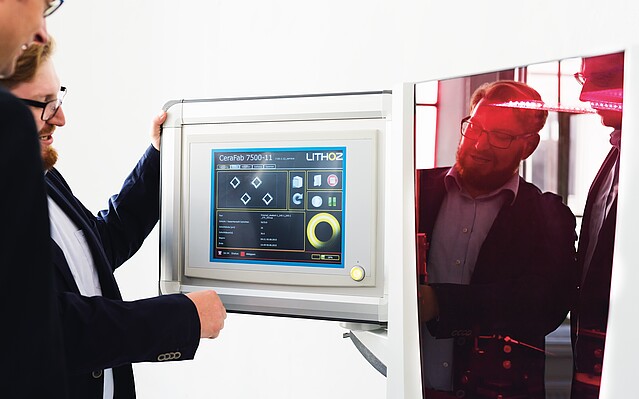Lithoz: Revolutionary 3D-printed bone implants
April 29, 2024|LD
From Vienna-based startup to global tech leader – how Lithoz is reshaping modern medicine through additive manufacturing
The Austrian 3D printing pioneer Lithoz, along with its spin-off Incus, has emerged as a global leader in lithography-based ceramic and metal additive manufacturing (LCM). This cutting-edge technology enables the production of intricate 3D objects layer by layer. With its high-precision printers and innovative materials, Lithoz is opening new frontiers – both in industrial production and, most notably, in modern medicine. The company’s latest breakthrough: successful application of 3D-printed ceramic implants.
Bones from the 3D printer?
What once sounded like science fiction is now a medical reality. Thanks to years of research by Lithoz founders Dr. Johannes Homa and Dr. Johannes Benedikt at TU Wien, customized bone implants from a 3D printer are no longer a futuristic idea. Their proprietary printing process allows for the creation of complex ceramic structures that are biologically compatible, customizable, and support tissue regeneration.
The company’s flagship projects include tailor-made implants, bone scaffolds, and even highly complex blood pumps.
“In severe bone fractures, the challenge is that bones don’t always heal or regrow on their own. Our method allows us to precisely print the missing part of the bone,” explains CTO Johannes Benedikt, highlighting the regenerative and adaptable potential of Lithoz’s ceramic scaffolds.
A milestone in surgery
Lithoz is demonstrating how modern technology is revolutionizing healthcare. For the first time, custom 3D-printed ceramic implants have been successfully used in complex surgical cases – such as patients with severely damaged jawbones. Where a complicated bone graft would previously have been necessary, a tailor-made implant from the 3D printer now suffices.
A recently published long-term study marks a groundbreaking medical milestone. Over five years, patient-specific implants made from LithaBone – a material developed by Lithoz – were tested. The results show a remarkable success rate of over 92%. These implants, produced using the Lithoz CeraFab printer, were used in patients who had lost bone mass following jaw surgery. The study found that the implants seamlessly integrated into the bone, reliably bridging gaps and promoting natural healing. Even more impressively, the innovative material enabled the body to generate new bone tissue – without the need for additional surgical intervention.
This marks a defining moment not only for Lithoz but also for the entire additive manufacturing industry – showcasing how technological innovation can directly and meaningfully improve patients’ quality of life.


From research lab to global stage
Lithoz is a prime example of Vienna’s excellence in additive manufacturing – and a testament to the city’s strong culture of innovation and cutting-edge university research. Founded in Vienna in 2011 as a spin-off of TU Wien, Lithoz has evolved into a global market leader in ceramic 3D printing. With new production sites in Albany (USA) and Shanghai (China), the company is expanding its international reach.
“The USA and Asia are our main target markets. We’re already collaborating with Tsinghua University in China, which specializes in ceramics,” says Homa. “There’s huge potential. We’ve found that our American clients are especially open-minded and innovative,” adds Benedikt.
Big shoes to fill – and a bold vision
Lithoz continues to be a driver of innovation – not only in its own field, but also by supporting new ventures. Eight years after Lithoz was founded in 2011, Homa and Benedikt are now also supporting Gerald Mitteramskogler in setting up the spin-off Incus. The aim is to extend 3D printing to metals and open up new industrial applications. With ultra-precise metal components, Incus is following in the footsteps of its parent company – and quickly positioning itself among the top global players.
Today, Incus conducts its research and production at the Technology Centre Seestadt, one of Vienna’s most advanced facilities for technology companies.
“Since our first visit in 2019, the Seestadt area has grown immensely. I believe Incus will follow a similar path. I’m fully convinced of our technology and its potential – and that we’ll grow just as fast and impressively as our surroundings,” says Gerald Mitteramskogler, CEO of Incus.
Lithoz
Leistungen der Wirtschaftsagentur Wien
Funded through the programme Material Goods in 2016 and 2020
Funded through the programme Production in the City in 2019
Förderung ProduktionFunded through the programme From Science to Products in 2019
Funded through the programme Co-Create in 2017
Funded through the programme Internationalisation in 2013, 2014, 2015 and 2016
International Market Entry FundingFunded through the programme Innovation in 2012 and 2016
Innovation Funding